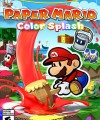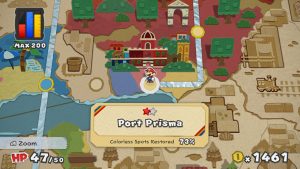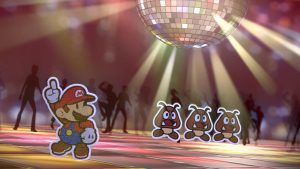When it comes to non-traditional Mario titles, the Paper Mario series is definitely a favorite of mine. Even with that said, I fell off a bit with Paper Mario: Sticker Star on the Nintendo 3DS. I was unable to fully complete that game due to certain battle mechanics. It’s not too surprising to see the Paper Mario titles stray off the RPG path since Super Paper Mario already did something to that extent. So when Paper Mario: Color Splash was unveiled, I was immediately intrigued by it, even if Sticker Star left a sour taste in my mouth. The game looked great in HD and had that charm kept well intact. Of course, as more info was shared, it was clear that this wouldn’t be a return to its RPGs roots for the franchise. Instead, Color Splash was looking to build upon the base of Sticker Star. I was certainly skeptical of the decision, but Color Splash actually surprised me in the end.
Paper Mario: Color Splash brings back the battle system present in Sticker Star. Trading in stickers for cards in order to input which attacks you’ll perform in the battle. From there, the rest is familiar to those who have played the other Paper Mario titles. Timing button presses will help enhance attacks in order to increase damage. With the card system, a paint mechanic is also added. You’ll come across cards with no color and you’ll have the option to apply paint to them. Doing so will add power to the attack, the more paint applied, the higher the damage it will put out.
Aside from the battles, the rest of the game feels like traditional Paper Mario. It’s still not an open world like the old Paper Mario, since its the same as Sticker Star with the game being split into separate stages. I didn’t mind this part as much when it first appeared, and I actually like it in Color Splash.
The story of Color Splash starts with a letter sent to Princess Peach, who then visits Mario in order to share the letter. It is soon found out that the letter is actually a Toad that had the color sucked off from him. Mario and Peach then head to Prism Island, where the letter was sent from. Once there, they reach an empty town filled with colorless spots. They eventually meet Huey, a magical paint can that gives Mario the ability to bring back color to the world. From there, the adventure begins as Mario and crew figure out what happened to Prism Island and its color.
THE GOOD: Having the world split into stages, kind of gave me that feel of traditional Mario games, mainly the 3D ones. Where each stage you encountered felt like it’s own little world, with it’s own unique story to tell. That feeling was present in Color Splash and made me look forward to the next stage as I played.
The stages themselves were also great. They had that open world feel of what traditional Paper Mario had, but more compact. My favorite things about them though were the puzzles or obstacles you would come across. Some of them are quite clever and completing them gave off a satisfying feel. There are even levels that will have little to no battles at all, and will have to be completed solely by solving puzzles. Each stage felt different from the last and fun to go through in their own ways.
One neat little thing with each of the levels too is that there are blank spots scattered throughout. You’ll need to hit them with paint from Mario’s hammer in order to restore color. Several of these spots are easily accessible. While others takes some extra thinking and effort to reach. The game even encourages you to fully paint the stages since it keeps track of the percentage of how much of the stage you’ve fully colored. Going through each of the levels and trying to obtain that 100% was nice side thing to do, and reminded me of that feeling I’ve gotten when trying to clean all the mess that was in Super Mario Sunshine.
Also adding further charm to the world of Color Splash is the game’s great writing. The Mario RPGs have a reputation for having clever and funny writing, and that continues with Color Splash. There aren’t voice overs present, so there’s lots of reading in these Mario games. However, with good writing, it’s hardly an issue and I’ve enjoyed reading through the game.
With Sticker Star, Paper Mario made its handheld debut. With Color Splash, the series finally makes the jump to HD and it looks fantastic. The paper craft aesthetic really shows up well on the Wii U. The worlds are colorful, more so with the game’s paint theme, and thanks to the higher resolution, things looks like actual paper and cardboard.
Lastly, one of the big improvements I found with Color Splash over Sticker Star is that battles feel worth going through this time. With Sticker Star, the battles felt needless since the payoff for winning them didn’t feel worth it. I often found myself just avoiding enemies since battles just felt like a waste of time. In Color Splash, battles are much more rewarding. Not only do they give you coins and paint to refill with, they also drop Hammer Scraps. Obtaining enough Hammer Scraps will level up your hammer, so that you can hold more paint. Paint is quite crucial to the game, since you need paint in order to fill colorless spots, and also to provide color to your battle cards in order to increase their power. So having a much bigger supply on hand is very useful. So getting rewarded with Hammer Scraps helps encourage players to engage in battles, and also does provide that slight feel of an RPG feeling since you are kind of leveling up something.
THE BAD: The big thing for many with this latest Paper Mario release will mainly fall with the game’s battle system. It’s no longer as straightforward as the original Paper Mario titles and it’s less RPG. Yes, the timed button presses remains intact, but performing attacks is quite the routine. First you have to navigate through all your battle cards for the attack you want, which can be a bit of a task in itself if you’re holding a huge supply of cards. Since you can only scroll through your cards from one end to the other. Once you obtain the desired battle card, you then have the option of applying paint if needed. You do this by pressing on the card via the gamepad’s touchscreen or with a button press, depending on your control scheme. After applying color, you then flick the card up and it will finally be put into play.
Explaining the steps makes it feel more tedious than it actually is, but it is a bit of extra work that feels forced. Sure, it helps bring in the paint mechanic into play. However, it kind of makes things feel longer than they need to be. Also, paint aside, I do prefer a traditional setup over the battle cards. Having to make sure you’re supplied well enough for any upcoming battles can also feel tedious and also make things harder than they need to be. Every action is tied to a card, even healing. If you’re not on top of things, you can find yourself in some odd situations. Like fighting a spiked enemy with only jump cards available. It’s not going to work since the spikes hurt Mario. There is a Battle Spin option for these types of moments that will aid you in obtaining more cards while in a battle. However, just the fact that moments like this can be made, shows how flawed the system is.
This situation becomes more apparent when you engage in a Kamek battle. It’s random, but sometimes when you engage an enemy, Kamek will make an appearance. If Kamek appears, he will apply a random ailment that will give you a slight disadvantage in battle. Things like turning your cards face down or even removing a majority of your cards and leaving only 6 or so. He will then get rid of your ability to use Battle Spin and to flee the battle. Its all completely random when Kamek will appear and what effect he will apply. Since it applies to any enemy, there’s always the potential of it having drastic consequences if you’re really unlucky, like to the point of making an easy battle become a really tedious one. I had one of these moments occur when I was facing a spiked enemy, and Kamek flipped my cards face down. I had no idea where the the hammer cards were and used up many cards that either healed me or jumped on the enemy. Basically cards that didn’t make the situation any better. It’s a rare case that didn’t happen often, but when it happens, it really sucks.
Another bad case of randomness can occur with the Shy Bandit who can appear at any time on the stage select screen. As I mentioned earlier, one of the things I enjoyed was obtaining 100% on a stage by painting in all the blank spots. Unfortunately, it’s not a permanent thing thanks to the Shy Bandit. When a Shy Bandit appears, he’ll start heading to a stage and start sucking out its color. If you don’t reach him in time, your 100% on that stage will be reset to 0%. Since his appearance is random and the stage he aims for is random, there is potential of you being in a bad spot when he appears and having it be impossible to reach him in time to stop him. Just the fact that something like this exists that can erase effort like that is a big negative for me. So having randomness also applied to it, just makes it worse.
This next complaint can be seen as minor, but it’s also a weird thing that occurs in the game. One of the things I liked with the Paper Mario series were the various and unique characters you encountered. In Color Splash, there’s not much of that present. You do have your partner Huey, but other than that, all the friendly characters you meet along the way are Toads. More worse is that they’re not even different looking Toads, they are literally the same looking character, with some minor color changes. It would’ve been nice for a character described as a “old professor” to have been a old looking character or to even have a beard. Nope, it’s just a Toad. It’s kind of funny to think about, but also felt very uninspiring.
My final knock on the game is with the boss fights. Back in Sticker Star, if you didn’t have a specific Thing item, which act like very powerful special attacks, boss fights can be become difficult. With Color Splash, if you don’t have the proper Thing Card on hand, the boss fight will be impossible. So boss fights feel more like a puzzle than an actual fight. Once you solve that puzzle, the battle is pretty much over. Not too big an issue, but the game likes to throw a lot of hints at you in order to ensure you understand that you’ll need a specific item before you head into the battle. So it’s not that much of a puzzle, and more of a needing to make sure you have the proper item with you before you fight the boss.
OVERALL THOUGHTS: If you were to ask me which type of Paper Mario I would like to see in the future, I am in that camp that would like to see the original setup make a return. I wouldn’t even mind seeing something similar to what Super Paper Mario was. This current battle system is certainly my least favorite, but I was able to tolerate it more this time around compared to Sticker Star. While the randomness is also a pain to deal with if you find yourself unlucky, it didn’t occur enough to draw me away. The idea of those possibilities though makes me feel unpleasant.
Complaints aside, I actually enjoyed my time with Paper Mario: Color Splash. The game looks great on the Wii U and the writing was a joy to read. The puzzles were also clever and satisfying to solve. Overall, I felt that the positives outweighed the negatives. Most of the stuff in the game felt fun to play through, that the issues I did have weren’t offensive enough to stop me from continuing. And in the end, I can happily say that I at least liked what I played. It’s not the Paper Mario RPG that I wanted, but it’s also not terrible either. So I’m hopeful for the future of the series and am very much looking forward to what will come out next.

















You must be logged in to post a comment.